Collection of Coins of Cilicia / Κιλικία
Olba / Ολβη

RPC Map
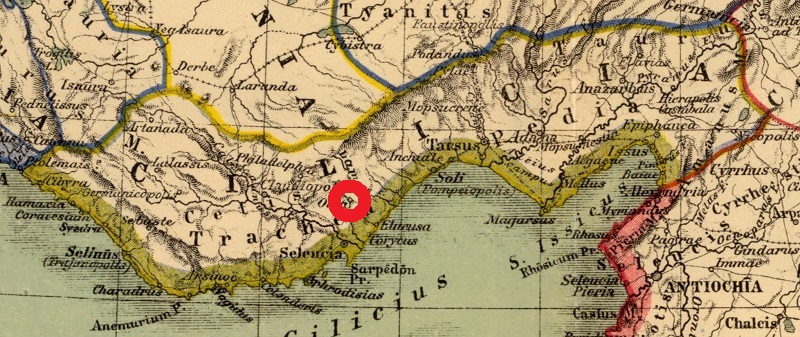
Ex H.Kiepert, Atlas antiquus, Berlin, Reimer, ca. 1875 AD
| Olba
(Όλβα, heute Ura) und Diokaisareia (Διοκαισάρεια, lateinisch
Diocaesarea, heute Uzuncaburç) sind zwei zusammengehörige
antike Städte in Kilikien, im Landkreis Silifke der Provinz Mersin
in der heutigen Türkei. Die Städte liegen etwa 20 Kilometer
Luftlinie nordwestlich von Korykos und 25 Kilometer nördlich von
Seleukia auf einem über 1000 Meter hoch gelegenen Plateau. Laut
Strabon (14, 5, 10) lag Olba in dem bergigen Land oberhalb von Kyinda
und Soloi. Olba war Sitz einer Priesterdynastie, deren Heiligtum, der
Tempel des Zeus Olbios etwa 4 km westlich lag. Um diesen Tempel
entwickelte sich die Stadt Diokaisareia.[1] Zu Olba gehörte auch
das etwa 30 km südöstliche liegende Kanytelleis. William Mitchell Ramsay setzt das hethitische Ura mit Olba gleich. Diese Gleichsetzung wird heute allgemein angezweifelt, die Namensgleichheit mit dem heutigen Dorf Ura als Zufall angesehen. Die Priester des Zeus Olbios herrschten über den Teil der Tracheiotis zwischen dem Kalykadnos (Güksu) im Westen und dem Lamos (Limonlu Çayı) im Osten, bis Zenophanes die Herrschaft erlangte. Von ihrer Herrschaft zeugen die in zahlreichen Orten der Region vorhandenen Olbischen Zeichen an Türmen und Gebäuden. Eine Nachfahrin aus dem Geschlecht namens Aba unterstützte laut Strabon Marcus Antonius und Kleopatra VII. und wurde deshalb von Augustus gestürzt, aber die Herrschaft über Olba blieb in ihrem Geschlecht. An der Stirnseite einer Wand des Zeustempels bei Korykion Antron findet sich eine Liste der Priesterherrscher, die von 3. bis zum späten 1. Jahrhundert v. Chr. reicht. Etwa mit der Entstehung der römischen Provinz Cilicia im ersten nachchristlichen Jahrhundert verlor die Priesterdynastie an Macht. Spätestens um diese Zeit wurde um den Zeustempel die Stadt Diokaisareia gegründet, das Heiligtum des Zeus Olbios verlor die regionale Bedeutung und wurde zum Stadtheiligtum. Die heute sichtbaren Relikte von Diokaisareia stammen, bis auf den Tempel selbst, aus dieser Ausbauphase in der frühen Kaiserzeit. In der Spätantike verlor Olba gegenüber der neuen Stadt an Bedeutung, beide blieben aber bis ins 7./8. Jahrhundert Bischofssitze (Suffraganbistümer von Seleukia). [Wikipedia] History & Arcaeology livius.org Polemon II of Pontus Marcus Antonius Polemon Pythodoros, also known as Polemon II of Pontus and Polemon of Cilicia (Greek: Μάρκος Ἀντώνιος Πολέμων Πυθόδωρος; 12 BC/11 BC–74) was a prince of the Bosporan, Pontus, Cilicia and Cappadocia. He served as a Roman Client King of Pontus, Colchis and Cilicia. Polemon II was the second son and middle child of the Pontic Rulers Polemon Pythodoros and Pythodorida of Pontus. His eldest brother was Zenon, also known as Artaxias III, who was Roman Client King of Armenia and his youngest sister was Antonia Tryphaena, who was married to Cotys VIII, King of Thrace. Polemon II’s father died in 8 BC. His mother then married King Archelaus of Cappadocia, and the family had moved to Cappadocia, where Polemon II was raised, along with his siblings, at the court of his stepfather. Archelaus died in 17, whereupon Polemon II and his mother moved back to Pontus. From 17 until 38, Polemon II lived as a private citizen in Pontus and assisted his mother in the administration of their realm. When his mother died in 38, Polemon II succeeded his mother as the sole ruler of Pontus, Colchis and Cilicia. According to an honorary inscription at Cyzicus in 38, Polemon II participated in celebrating the local games in the city, honoring Julia Drusilla, the late sister of Caligula; in this way Polemon II expressed his loyalty to the emperor and the Roman state. Polemon II with another Roman Client King Antiochus IV of Commagene, held athletic games in honor of Claudius in Cilicia in 47. Antiochus IV with Polemon II had showed favor towards Claudius in which they offered significant services to him. Around 50, Polemon II was attracted to the wealth and beauty of the Judean princess Julia Berenice, whom he had met in Tiberias during a visit to King Agrippa I. Berenice in turn wanted to marry Polemon II to end rumors that she and her brother were committing incest. Berenice was previously widowed in 48 when her second husband, her paternal uncle Herod of Chalcis, died. She had two sons by him, Berenicianus and Hyrcanus. Berenice however set the condition that Polemon II had to convert to Judaism, which included undergoing the rite of circumcision, before marriage. Polemon II assented, and the marriage went ahead. It did not last long however, and Berenice left Pontus with her sons and returned to the court of her brother. Polemon II abandoned Judaism and, according to the legend of Bartholomew the Apostle, he accepted Christianity, but only to become a pagan again. At an unknown date perhaps after the early 50s, Polemon II married a princess called Julia Mamaea who was from the Syrian Roman Client Emesene Kingdom. Mamaea was of Assyrian, Armenian, Greek and Median ancestry. Polemon II married Mamaea as his second wife and the circumstances that lead Polemon II to marry her are unknown. Through Mamaea’s marriage to him, she became a Roman Client Queen of Pontus, Colchis and Cilicia. The relationship between Polemon II and Mamaea is unknown. Mamaea marrying Polemon II is only known through surviving evidence. Her name and identity is revealed from surviving bronze coinage. Surviving coinage that was issued from Polemon II and Mamaea is extremely rare, as only three specimens are known. On surviving coinage, shows her royal title in Greek ΙΟΥΛΙΑΣ ΜΑΜΑΙΑΣ ΒΑΣΙΛΙΣΣΗΣ (of Julia Mamaea the Queen) or ΒΑΣΙΛΙΣΣΗΣ ΙΟΥΛΙΑΣ ΜΑΜΑΙΑΣ (of Queen Julia Mamaea). These coins can be dated from the second half of Polemon II’s reign from 60 until 74. She bore Polemon II two sons who were Polemon and Rhoemetalces. Her sons that she bore to Polemon II are known from a restored surviving inscription from Amphipolis Greece, that is commemorating Polemon II, Polemon and Rhoemetalces is dated from the second half of the 1st century. Polemon II renamed the town Fanizan and named the town after himself to Polemonium (modern Fatsa Turkey). In 62, Nero induced Polemon II to abdicate the Pontian throne, and Pontus, including Colchis, became a Roman province. From then until his death, Polemon II only ruled Cilicia. [Wikipedia] |
| Olba Cilicia -
Centering
Statististics |
||||
obverse Image |
no
centering -/- |
onesided centering +/- or -/+ |
twosided centering +/+ |
Comments |
| Augustus
27 BC-14 AD |
12
|
|||
| Dominium
Romanum 1-100 AD |
2 |
|||
| Tiberius
14-37 AD |
8 |
|||
| Nero
54-58 AD |
3 |
|||
| Galba
68-69 AD |
2 |
|||
| Titus
79-81 AD |
3 |
|||
| Domitianus
81-96 AD |
1 |
|||
| Hadrianus
117-138 AD |
2 |
|||
| Antoninus
Pius 138-161 AD |
2 |
|||
| Lucius Verus 161-169 AD | 2 |
|||
| Faustina
jr. 161-176 AD |
2 |
|||
| Marcus
Aurelius 161-180 AD |
4 |
|||
| Lucilla
164-182 AD |
2 |
|||
| Commodus
177-192 AD |
1 |
|||
| Septimius
Severus 193-211 AD |
2 |
|||
| Septimius
Severus & Iulia Domna 193-211 AD |
2 |
|||
| Caracalla
198-217 AD |
1 |
|||
| Trebonianus
Gallu 251-254 AD |
1 |
|||
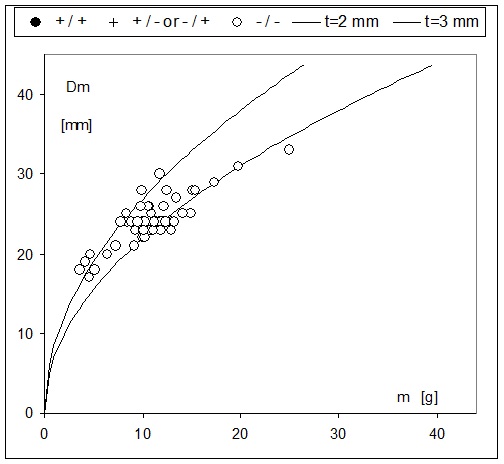
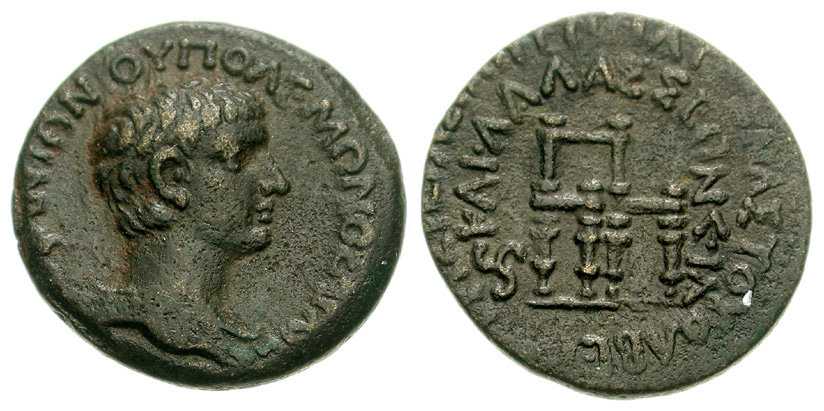 |
| SHH v4395 |
| Polemo II High Priest / Throne AE 10.41 g 25 mm -/- Polemo II 28-38 AD RPC I 3738 CNG 141E/151 |
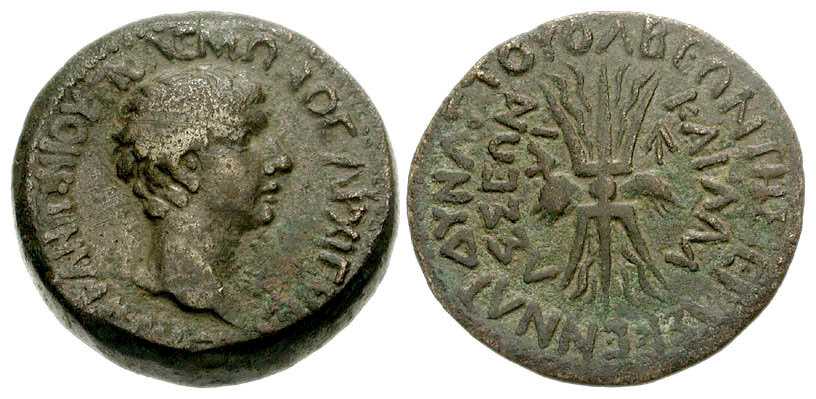 |
| SHH v4394 |
| Polemo II High Priest / Thunderbolt AE 15.66 g 24 mm -/- Polemo II 28-38 AD RPC I 3739 CNG 149E/249 |
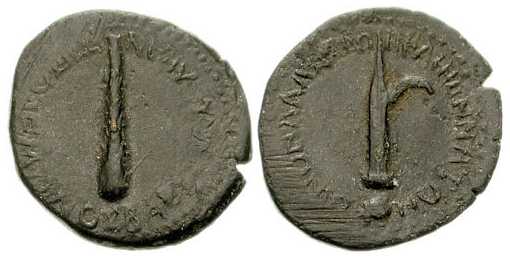 |
| SHH v4396 |
| Club (Polemo III High Priest) / Harpa on
Globe AE 2.41 g 16 mm -/- Polemo III 41-69 AD Levante 644 CNG 134E/240 |
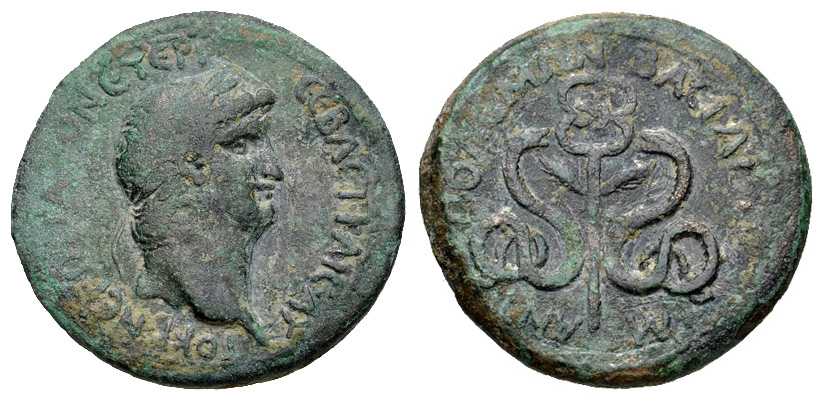 |
| SHH v4393 |
| Nero ( & Polemo II King) / Winged
Caduceus AE 12.50 g 28 mm -/- Nero 54-68 AD RPC I 3740 CNG 271E/343 |
 |
| SHH v4392 |
| Galba ( & Polemo II King) / Minerva AE 10.27 g 22 mm -/- Galba 68-69 AD RPC I 3741 CNG 297E/181 |
| |
